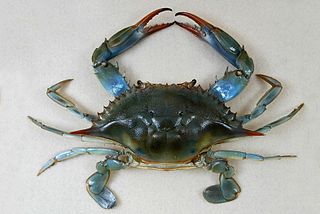
Callinectes sapidus, the blue crab, Atlantic blue crab, or, regionally, the Maryland blue crab, is a species of crab native to the waters of the western Atlantic Ocean and the Gulf of Mexico, and introduced internationally.

Marie Firmin Bocourt was a French zoologist and artist.

Mary Jane Rathbun was an American zoologist who specialized in crustaceans. She worked at the Smithsonian Institution from 1884 until her death. She described more than a thousand new species and subspecies and many higher taxa.

Callinectes is a genus of crabs, containing 16 extant species, including the Atlantic blue crab, C. sapidus:

Basa, as it is commonly referred to, is a species of primarily freshwater-dwelling catfish in the shark-catfish family, Pangasiidae, native to the Mekong and Chao Phraya river basins of Mainland Southeast Asia. Economically, these fish are important as a regional food source, and are also prized on the international market. Outside of Asia, such as in North America or Australia, they are often referred to as "basa fish" or "swai" or by their specific name, "bocourti". In the United Kingdom, all species of Pangasius may, legally, be described as "river cobbler", "cobbler", "basa", "pangasius" or simply "panga", as well as any of these names with the addition of "catfish". In the rest of mainland Europe, these fish are mostly sold as "pangasius" or "panga". In Asian fish markets, names for basa also include "Pacific dory" and "patin". Other, related shark-catfish species may occasionally be labeled—albeit incorrectly—as basa, including the iridescent shark and the yellowtail catfish.

Portunidae is a family of crabs which contains the swimming crabs. Its members include many well-known shoreline crabs, such as the blue crab and velvet crab. Two genera in the family are contrastingly named Scylla and Charybdis; the former contains the economically important species black crab and Scylla paramamosain.

The terror skink, also called commonly Bocourt's terrific skink, Bocourt's eyelid skink and Bocourt's skink, is a species of lizard in the family Scincidae. The species is endemic to the Île des Pins, a small islet off the coast of New Caledonia. First described in 1876, the species was presumed to be extinct, but was rediscovered in 1993, and since then several individuals have been seen. Because of its small area of occupation and small population size, the International Union for Conservation of Nature has assessed its conservation status as being "critically endangered".
Hematodinium perezi is a pathogenic dinoflagellate parasite that infects crustaceans, including the Blue Crab and Norway Lobster and has been observed to have a significant impact on crustacean fisheries. Infected crustaceans frequently show signs of weakness and lethargy, and often die due to stress-related handling from fishing as well as metabolic exhaustion due to reduced feeding. This parasite is known to be quite transmissible between various crustacean hosts.

Callinectes exasperatus is a species of swimming crab native to the western Atlantic Ocean. The diet of this species is carrion. They are not commercially fished.

Callinectes marginatus, commonly known as the sharptooth swimcrab or marbled swimcrab, is a species of swimming crab in the family Portunidae.

Callinectes ornatus is a species of swimming crab in the genus Callinectes. It can be distinguished from the closely related Atlantic blue crab by the presence of six frontal teeth on the carapace, compared with only four for C. sapidus. C. ornatus is also smaller, at a maximum carapace width of only 93 millimetres (3.7 in), compared to 230 mm (9.1 in) in C. sapidus, and is therefore not commercially exploited.

Crab fisheries are fisheries which capture or farm crabs. True crabs make up 20% of all crustaceans caught and farmed worldwide, with about 1.4 million tonnes being consumed annually. The horse crab, Portunus trituberculatus, accounts for one quarter of that total. Other important species include flower crabs, snow crabs (Chionoecetes), blue crabs, edible or brown crabs, Dungeness crab, and mud crabs, each of which provides more than 20,000 tonnes annually.

Callinectes similis, sometimes called the lesser blue crab or dwarf crab, is a West Atlantic species of blue crab. It was described by Austin B. Williams in 1966.
Hematodinium is a genus of dinoflagellates. Species in this genus, such as Hematodinium perezi, the type species, are internal parasites of the hemolymph of crustaceans such as the Atlantic blue crab and Norway lobster. Species in the genus are economically damaging to commercial crab fisheries, including causing bitter crab disease in the large Tanner or snow crab fisheries of the Bering Sea.
The crucifix sea catfish — also known as the Christfish, the crucifix/crucifex catfish, the crucifixfish, or the gillbacker, — is a species of catfish in the family Ariidae.












